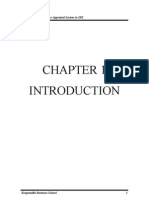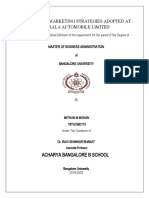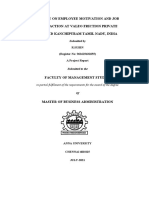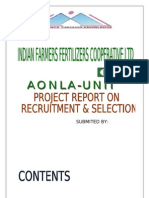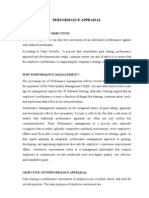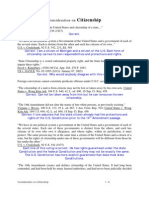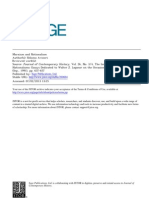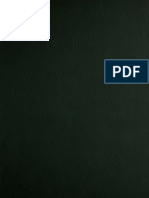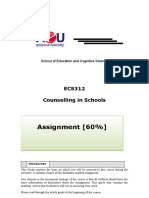TNPL PJT
TNPL PJT
Uploaded by
Anirudh SubramanianCopyright:
Available Formats
TNPL PJT
TNPL PJT
Uploaded by
Anirudh SubramanianOriginal Title
Copyright
Available Formats
Share this document
Did you find this document useful?
Is this content inappropriate?
Copyright:
Available Formats
TNPL PJT
TNPL PJT
Uploaded by
Anirudh SubramanianCopyright:
Available Formats
1.
INTRODUCTION INTRODUCTION HUMAN RESOURCE MANAGEMENT: Human resource management (HRM) is a relatively modern label for the range of themes and practices involved in managing people. It is defined and described in a variety of (sometimes contradictory) ways. This excerpt from Human Resource Management in a Business Context introduces the concept of human resources management. It outlines HRM as a philosophy of people management and provides a framework for its role within the business context. Human resource management has not 'come out of nowhere'. HRM has absorbed ideas and techniques from a number of areas. In effect, it is a synthesis of themes and concepts drawn from over a century of management theory and social science research. Like fashions in hairstyle and clothing, management ideas come and go. However, a consistent theme has prevailed for over twenty years: the most successful organizations make the most effective use of their people - their human resources. PERSONNEL MANAGEMENT: The renewed emphasis on the importance of human resources in the 1980s and 90s drew attention to the way in which people management was organized. Specifically, this meant a critical review of the functions of personnel management. Personnel management has been a recognized function in the USA since NCR opened a personnel office in the 1890s. In other countries the function arrived more slowly and came through a variety of routes. This excerpt from Human Resource Management in a Business Context looks at Personnel Management from a historical perspective.
Specialist Personnel Functions:
Recruitment - advertising for new employees and liaising with Selection - determining the best candidates from those who apply, Promotion - running similar selection procedures to determine progression Pay - a minor or major role in pay negotiation, determination and Performance assessment - co-ordinations staff appraisal and counseling Grading structures - as a basis for pay or development, comparing the Training and development - co-ordination or delivering program to fit Welfare - providing or liaising with specialists in a staff care or counseling Communication - providing internal information service, perhaps in the Employee Relations - handling disputes, grievances and industrial action, Dismissal - on an individual basis as a result of failure to meet
employment agencies.
arranging interviews, tests and references.
within the organization.
administration.
systems to evaluate individual employee performance.
relative difficulty and importance of functions.
people for the roles required by the organization now and in the future.
role for people with personal or domestic problems affecting their work.
form of staff newspapers or magazines, handouts, booklets, videos.
often dealing with unions or staff representatives.
requirements or as part of a redundancy, downsizing or closure exercise, perhaps involving large numbers of people.
Personnel administration - record-keeping and monitoring of legislative
requirements related to equal opportunities and possibly pensions and ta
HUMAN RESOURCE MANAGEMENT IN INDIA Over many centuries India has absorbed managerial ideas and practices from around the world. Early records of trade, from 4500 B.C. to 300 B.C., not only indicate international economic and political links, but also the ideas of social and public administration. The world's first management book, titled 'Arlhashastra', written three millennium before Christ, codified many aspects of human resource practices in Ancient India. This treatise presented notions of the financial administration of the state, guiding principles for trade and commerce, as well as the management of people. These ideas were to be embedded in organizational thinking for centuries (Rangarajan 1992, Sihag 2004). Increasing trade, that included engagement with the Romans, led to widespread and systematic governance methods by 250 A.D. During the next 300 years, the first Indian empire, the Gupta Dynasty, encouraged the establishment of rules and regulations for managerial systems, and later from about 1000 A.D. Islam influenced many areas of trade and commerce. A further powerful effect on the managerial history of India was to be provided by the British system of corporate organization for 200 years. Clearly, the socio cultural roots of Indian heritage are diverse and have been drawn from multiple sources including ideas brought from other parts of the old world. Interestingly, these ideas were essentially secular.
OBJECTIVES OF THE STUDY The main objectives of the study are:
1.
To find out the awareness about work-life balance between employees in
the organization. 2. Find out whether work-life balance is been possible in todays
environment. 3. 4. 5. To identify the level of stress faced by the employees. Analysis whether work or family which is termed as an important one. To identify the satisfaction of employees with reference to the facilities
offered by the management.
6.
To identify the various important factors employees consider in improving
the work-life balance in the organization.
SCOPE OF THE STUDY The research study was conducted to know the employees perception regarding Work-Life balance. The study covers 125 employees of Ashok Leyland working in Chennai corporate office. The research findings will help the company to frame certain strategies to help the employees to balance their work and their personal life.
RESEARCH METHODOLOGY Research Research comprises defining and redefining problems, formulating hypothesis or suggesting solutions, collecting, organizing and evaluating data; making deduction and research conclusions; and at last carefully testing the conclusion to determine whether they fit the formulating hypothesis. Research Methodology Research methodology is a way to systematically solve the research problem. It may be understood as a science of studying how research is done scientifically. Research Design Descriptive research design has been adopted for the study. Descriptive studies are concerned with describing the characteristics or behavior of a particular individual or a group. Most of the social research comes in this category. The study was conducted in Ashok Leylands Chennai corporate office. Sampling Design Simple random sampling was adopted for the study. A simple random sampling is a sample generated by a process that guarantees in the long run, that every possible sample of a given size will be selected with known and equal
probability. This method was found to be the most convenient and suitable for the study.
Sampling Size The sample size for the above mentioned study is divided as shown below. Nomenclature Male Female Total Duration Duration of the study was 1 Month. Nature and Sources of Data Primary data was collected for the project. Primary data was collected by means of questionnaires. Apart from this secondary data was also collected from Ashok Leylands annual reports, manuals, website, and various journals. Discussions with the staff members also helped to great extent in extracting valuable information. Questionnaire Construction In order to make the questionnaire effective the sequence of the questions was given major importance. A set of 14 questions was prepared for the employees. The questions constructed were simple and concrete. The structured questionnaire helped in generating information to the point. Number of Sample 104 21 125
Advantages of using questionnaire method 1. 2. Data analysis was simple with the structured questionnaire. Reliable data could be obtained as the respondents were given the option
to choose. 3. It was possible to closely evaluate the preference of the respondents from
their expression. Method of Data Collection The data collection was been done by meting the respondents personally and by administering the questionnaires. General options and views of the respondents were recorded and taken into consideration for analysis. Presentation of the Data After the collection of data it was edited to assure consistency and uniformity in the responses and to arrive at a conclusion. Graphical representation also helped a great deal. Simple percentage analyses were used in a data presentation, which helped in bringing out the real differences of the deviation from the reality.
LIMITATIONS OF THE STUDY
1.
Since the study was confined in Chennai corporate office alone the
findings are applicable only to the employees of Ashok Leyland in Chennai alone. 2. There is no proper response from the employees to get the complete
information needed for the research study. 3. The survey results are based on the information gathered from the
respondents. It might be possible that the information supplied might be exaggerated or biased. 4. Few of the employees are not in a position to give complete information
so it was difficult to process with incomplete data.
HISTORY OF WORK-LIFE BALANCE
The expression was first used in the late 1970s to describe the balance between an individual's work and personal life. In the United States, this phrase was first used in 1986. Over the past twenty-five years, there has been a substantial increase in work which is felt to be due, in part, by information technology and by an intense, competitive work environment. Long-term loyalty and a "sense of corporate community" have been eroded by a performance culture that expects more and more from their employees yet offers little security in return. Many Americans are experiencing burnout due to overwork and increased stress. This condition is seen in nearly all occupations from blue collar workers to upper management. Over the past decade, a rise in workplace violence, an increase in levels of absenteeism as well as rising workers compensation claims is all evidence of an unhealthy work life balance.
Employee assistance professionals say there are many causes for this situation ranging from personal ambition and the pressure of family obligations to the accelerating pace of technology.. According to a recent study for the Center for Work-Life Policy, 1.7 million people consider their jobs and their work hours excessive because of globalization. These difficult and exhausting conditions are having adverse effects. According to the study, fifty percent of top corporate executives are leaving their current positions. Although sixty-four percent of workers feel that their work pressures are "self-inflicted", they state that it is taking a toll on them. The study shows that seventy percent of US respondents and eighty-one percent of global respondents say their jobs are affecting their health. Between forty-six and fifty-nine percent of workers feel that stress is affecting their interpersonal and sexual relationships. Additionally, men feel that there is a certain stigma associated with saying "I can't do this".
STRESS AND WORK-LIFE BALANCE The number of stress-related disability claims by American employees has doubled according to the Employee Assistance Professionals Association in Arlington, Virginia.. It is clear that problems caused by stress have become a major concern to both employers and employees. Symptoms of stress are manifested both physiologically and psychologically. Persistent stress can result in cardiovascular disease, sexual health problems, a weaker immune system and frequent headaches, stiff muscles, or backache. It can also result in poor coping skills, irritability, jumpiness, insecurity, exhaustion, and difficulty concentrating.
10
Stress may also perpetuate or lead to binge eating, smoking, and alcohol consumption.
The feeling that simply working hard is not enough anymore is acknowledged by many other American workers. To get ahead, a seventy-hour work week is the new standard. What little time is left is often divvied up among relationships, kids, and sleep. This increase in work hours over the past two decades means that less time will be spent with family, friends, and community as well as pursuing activities that one enjoys and taking the time to grow personally and spiritually[citation needed].
WORK-LIFE BALANCE CONCERNS OF MEN AND WOMEN Similar discrimination is experienced by men who take time off or reduce working hours for taking care of the family. For many employees todayboth male and femaletheir lives are becoming more consumed with a host of family and other personal responsibilities and interests. Therefore, in an effort to retain employees, it is increasingly important for organizations to recognize this balance. WORK-LIFE BALANCE ISSUES & THEIR INFLUENCE ON CHILDRENS An increasing number of young children are being raised by a childcare provider or another person other than a parent; older children are more likely today to come home to an empty house and spend time with video games,
11
television and the internet with less guidance to offset or control the messages coming from these sources. No one knows how many kids are home after school without an adult, but they know the number is in the millions. Also, according to a study by the National Institute of Child Health and Human Development, the more time that children spent in child care, the more likely their sixth grade teachers were to report problem behavior. The findings are the results of the largest study of child care and development conducted in the United States; the analysis tracked 1,364 children from birth. PROFILE OF TNPL: Tamil Nadu Newsprint and Papers Limited (TNPL) was established by the Government of Tamil Nadu during early eighties to produce Newsprint and Printing & Writing Paper using bagasse, a sugarcane residue, as primary raw material. The Company commenced production in the year 1984 with an initial capacity of 90,000 tonnes per annum. Over the years, the production capacity has been increased to 2,45,000 tonnes per annum and the Company has emerged as the largest bagasse based Paper Mill in the world consuming about one million tones of bagasse every year. The Company is in the process of implementing the Mill Expansion Plan for increasing the capacity to 4,00,000 tonnes per annum from July 2010.
TNPL exports about 1/5th of its production to more than 30 countries. Manufacturing of quality paper for the past two and half decades from bagasse is an index of the companys technological competence. A strong record in adopting minimum impact best process technology, responsible waste management,
12
reduced pollution load and commitment to the corporate social responsibility make the company one of the most environmentally compliant paper mills in the world.
TNPLs VISION TNPLs vision is to be the market leader in manufacture of world-class ecofriendly paper adopting innovative technologies for sustainable development. TNPL - Maker of bagasse based eco-friendly paper.
TAMILNADU NEWS PRINTS AND PAPERS LIMITED ORGANISATION STRUCTURE
Board of Directors
Chairman & Managing Directors
GM (F & A) GM Director (Marketing) (Finance)
13
GM (HRD )
GM GM Director (R&D) (Operatio (Operations) n)
Chief of Violence &
GM F&A
- General Manager - Finance & Administration
HRD - Human Resources Development R&D - Research & Development TNPLs RESEARCH AND DEVELOPMENT AND QUALITY CONTROL TNPLs contemporary cutting edge technology processes and equipments along with a team of dedicated trained professionals ensure that customers always get consistent quality products. State of the art Online Process Control Systems installed at various stages of manufacturing processes continuously measure and control critical parameters. R&D and QC activities are aimed towards achieving companys corporate goals.
14
Sustained R&D efforts to support process for improvements in quality and
trouble shooting. o Customized support to customers and provide workable solutions for
specific problems. o Right quality and quantity of raw materials usage ensured through
structured sampling and testing. o Effective pollution abatement measures to meet all statutory and
mandatory norms which also fetch Carbon Credit benefits. o Set product norms/specifications to meet customer requirements based on
national/ international standards applicable. o Appraise conformance by inspection and testing of periodic samples in
one of the best equipped laboratories in the country. o Take corrective action, if necessary and sustain the standards achieved. R&D and QC department plays a pro active roll in meeting the companys environmental and quality policy.
TNPLs CORPORATE SOCIAL RESPONSIBILITY
15
TNPL, as a responsible corporate citizen, has ingrained the philosophy of Corporate Social Responsibility deeply into its value system. The company is consistently taking various community welfare initiatives for the benefit of the people living in the neighboring villages. During the year 2008-09, the company has spent an amount of about Rs.1.60 crores for various CSR activities. They serve in all the fields given below.
1. Education 2. Career and Knowledge development 3. Drinking Water 4. Medical and Public Health 5. Infrastructure and Road Improvements 6. Promotion of Sports and Recreation 7. Live stock and Cattle care 8. Development of Tamil Language and Culture 9. Greening the Environment & Other Community Welfare Activities focused towards Women and Children. "Talent-Expo. Information Technology - Online Integrated Information System (OIIS)
16
TNPL believes and invests in state of art technology. In association with CMC Ltd - TNPL has developed a comprehensive Online Integrated Information System (OIIS), which provides real time information for quick decision making. The Online Integrated Information System (OIIS) using Oracle 10g-R2 Database consists of 16 modules covering most of the functions in factory, corporate office and branches. All the modules are integrated. Centralized data base is maintained at factory. The infrastructure in the factory consists of 2 Nos. of HP Servers in cluster as application server and database server and Storage Area Network (SAN) providing for centralized data storage based on fibre channel with an automated tape backup system. There are 5 nos. of intel servers to cater to the need of firewall server, file server, proxy server, test database server and backup file server. One itanium server is being used as mail server. The computers in the factory are connected by Campus Area Network (CAN). The computers in the corporate office are connected by Local Area Network (LAN). The computers in factory and corporate office are connected through Wide Area Network (WAN). Similarly, the computers in the factory, corporate office and branches are connected through Virtual Private Network(VPN). As a first step towards e-CRM (Customer Relationship Management) and e-SCM (Supply Chain Management), marketing and materials activities are web enabled. TNPL maintains a Disaster Recovery System (DRS) at Bangalore for the valued data.
17
ENVIRONMENT
Environment Protection and management are integral part of TNPL's activities. TNPL has taken several measures for protecting the environment in line with its commitment for sustainable development. In its choice of raw materials, sources of energy, and production processes, as well as in product development, the objective is to minimize the pollution load on environment. In all its business operations TNPL takes social, economic and ecological considerations seriously.
TNPL is an unfolding saga of commitment to sustainable development. Guided by principles of environmental responsibility, TNPL manufactures and markets paper using materials and processes that help minimize waste, conserve resources and protect Earth's bio diversity. Its unfailing commitment to clean production techniques with minimum pollution load stand out as a bench mark in the industry. Recognizing, TNPL's commitment to preserving nature, the World Wide Fund for Nature - India (WWF) has endorsed TNPL as an eco-conscious company and has franchised its PANDA Logo to be used on TNPL's branded products. Through the adoption of sound ecological practices at every stage of activity, TNPL has not only brought down the pollution load but also improved the overall profitability through adoption of cleaner production technologies. Besides as a responsible corporate citizen the company has initiated many
18
community development activities to enhance the quality of life in and around TNPL which has brought in lot of goodwill. Harnessing of wind energy, adoption of greener technologies, resource conservation, responsible waste management and minimal pollution loads make TNPL one of the most environmentally compliant mills in the world. By using bagasse as primary raw material, TNPL preserves over 40000 acres of forest land from depletion every year. TNPL has also been adopting multi-pronged, ecologically sound approach towards waste minimization and cost reduction through adoption of cleaner production technologies. TNPL is accredited with ISO14001:2004 certification for an effective environmental management system. AWARDS TNPL has bagged the prestigious "Paper Mill of the year 2007-08" award.
The award is given in recognition of the Indian paper mill which sets an example in the areas of productivity, quality, human resource development, research & development, developing export markets, community services etc. besides striving to attain global competitiveness by the Indian Paper Manufacturers Association (IPMA), New Delhi. It has received the award in 2001-02 for TNPL's overall performance, approaches for meeting social obligations, ensuring global competitiveness and sustainable development & technology options. Delhi. TNPL bagged, the Certificate of Excellence in Productivity, Quality,
Innovation and Management from the "Institute of Economic Studies", New
19
Recognizing TNPL's concern for the environment, the Rotary Club of
Chennai (East) and Earth Care, bestowed the "Dr M.S. Swaminathan Award for Environment Protection 2002" on TNPL. TNPL has bagged the CAPEXIL "SPECIAL EXPORT AWARD" for the
10th consecutive year, for its outstanding export performance during the year 2007-08. The Government of India has given "TRADING HOUSE" status to TNPL
recognizing the export performance. TNPL has been bestowed the "Niryat Shree Award" by Federation of
Indian Export Organization (FIEO) for the high degree of excellence it has demonstrated in exports. TNPL has bagged ICWAI National Award for "Excellence in Cost
Management - 2008" (Second) under the category of Public Sector Manufacturing - Organization (Medium). The Award is given by the "Institute of Cost and Works Accountants of India" (ICWAI) for the best costing practices in the companies. TNPL was awarded the commendation award on "CII Leadership &
Excellence Award in Safety, Health & Environment (SH&E) year 2002". TNPL bagged the National Energy Conservation Award for the year 2001
from Government of India in recognition of its outstanding achievement in energy management.
Loyola Institute of Business Administration (LIBA) Chennai
adjudged TNPL as the "Best Corporate Citizen 1999".
20
PRODUCT PROFILE TNPL offers high-quality surface sized and non-surface sized paper to suit the needs of modern high speed printing machines. TNPL's cutting edge technology backed by experienced professionals ensures quality products to customers. TNPL s manufacturing processes are equipped with state-of-the-art control systems to maintain critical quality parameters on line. The paper produced by TNPL is eco- friendly as the pulp is manufactured out of renewable raw material and is subjected to Elemental Chlorine Free (ECF) bleaching. As the paper is acid free, it has a longer colour stability and enhanced permanency in terms of strength characteristics. TNPL caters to the requirements of multifunctional printing processes like sheet-fed, web offset, and digital printers. The paper reels have uniform profile with strength properties to cope even with high speed machines. TNPL manufactures Printing and Writing Papers in substances ranging from 50 GSM to 90 GSM. The products are as followed.
21
TNPL Ultra White Map litho TNPL Elegant Map litho Hi-Tech Map litho TNPL Map litho Radiant Printing Commander Hardbound Notebook TNPL Offset Printing Cream wove Copy Crown TNPL Copier Students' Favorites Super Print Map litho Perfect Copier Ace Marvel
22
23
TABLE-1 GENDER CLASSIFICATION OF EMPLOYEES
S. No.
Gender
N0. Of Respondents
Percentage (%)
1 2
Male Female Total
104 21 125
83 17 100
Inference It was found that about 83% of employees, were male and 17% of employees were female. Hence a majority of the selected respondents were male.
24
TABLE-2 AGE CLASSIFICATION OF EMPLOYEES S. No Age No of respondents Percentage (%) 1 2 3 4 Less than 30 31-40 41-50 More than 51 Total 11 8 52 54 125 9 6 42 43 100
Inference About 43% of the employees are in the age group of more than 51 and about 42% of the employees are in the age group of 41-50 and 9% of them are in the age group of less than 30 and about 6% of them are in the age group of 31-40.
TABLE-3
25
YEAR OF JOINING THE ORGANIZATION S. No. Year No. of respondents 1 2 3 1981-1990 1991-2000 2001-2010 Total 94 22 9 125 Percentage (%) 75 18 7 100
Inference: More than 70% of respondents were the one who joined TNPL between 19811990 and 18% were the one who joined during 1991-2000 remaining 7% were between 2001 and above. TABLE-4 CHANGE IN DESIGNATION FROM DOJ
26
S. No.
Promoted
N0. Of Respondents
Percentage (%)
1 2
Yes No Total
83 42 125
66 34 100
Inference It was been found that 66% of the employees were been promoted to higher post since their date of joining and 34% remain in the same post in which they were been appointed in the beginning.
TABLE-5
27
AWARENESS ABOUT WORK-LIFE BALANCE
S. No.
Awareness
N0. Of Respondents
Percentage (%)
1 2
Yes No Total
86 39 125
69 31 100
Inference About 69% of the employees were aware about work-life balance and remaining 31% were un-aware about it.
28
TABLE-6 POSSIBILITY OF WORK-LIFE BALANCE IN CURRENT ENVIRONMENT
S. No.
Possible
N0. Of Respondents
Percentage (%)
1 2
Yes No Total
73 52 125
58 42 100
Inference Nearly 58% of employees felt that work-life balance is possible in todays environment and 42% of them felt that work-life balance is not possible.
29
TABLE-7 IMPORTANCE FOR WORK & FAMILY S. No. Importance No. of respondents 1 2 3 Work Family Both (Work & Family) Total 19 8 97 125 Percentage (%) 15 7 78 100
Inference It was been observed that 78% of the employees feel that both work and family are important, 15% feel that work is more important than family and remaining 7% feel that family is more important than work.
TABLE-8
30
RANKS ON QUALITY AND TIME BOUND COMPLETION OF WORK S. No 1 Importance Proper instruction from 2 superiors Planning & time management 3 by myself Co- operation from peers and 4 5 subordinate Rational work load Realistic time dead line Total 11 8 125 9 6 100 11 15 125 9 12 100 34 13 125 27 10 100 16 52 125 13 41 100 53 37 125 42 31 10 0 11 9 16 13 56 45 25 20 17 13 42 34 37 29 22 18 15 12 9 7 1st Rank 53 % 42 2nd Rank 46 % 37 3rd Rank 0 % 0 4th Rank 17 % 14 5th Rank 9 % 7
Chart
31
Inference From the table it can be seen that various ranks are been given to quality and time bound completion of work.
32
TABLE-9 COMPLETION OF WORK IN OFFICE HOURS
S. No.
Possibilities
No. of respondents
Percentage (%) 42 57 1 100
1 2 3
Almost all the days Most of the days Very few days Total
52 71 2 125
Inference From the table it can be seen that 57% employees are able to finish their work in office hours itself most of the days while 42% of them were able to finish it almost all the days and 1% were able to finish it on very few days alone.
TABLE-10
33
RANK BASED ON IMPORTANCE S. No 1 2 3 Importance Attending family work Taking care of children Looking elderly 4 5 parents Pursuing hobbies Taking time for relaxing Total 0 8 125 0 6 100 0 2 125 0 1 100 22 18 125 18 14 100 25 50 125 20 41 100 78 47 125 62 38 10 0 1st Rank 26 79 12 % 21 63 10 2nd Rank 46 46 31 % 37 37 25 3rd Rank 21 0 64 % 17 0 51 4th Rank 32 0 18 % 25 0 14 5th Rank 0 0 0 % 0 0 0
34
Inference In the above table different kind of ranks are been assigned based on the preference and importance felt by the employee.
TABLE-11 WORK LOAD HINDRANCE FROM FAMILY RESPONSIBILITIES
35
S. No.
Hindrance
No. of respondents
Percentage (%) 30 55 15 100
1 2 3
Yes No Undecided Total
38 69 18 125
Inference It is been found that 55% of the employees feel that work load does not affect them from family responsibilities and 30% feel that work load affect them from taking part in family and other responsibilities and 15% says that its undecided. TABLE-12 FACTORS HINDERING FROM ATTENDING FAMILY RESPONSIBILITY
36
S. No 1 2 3 4 5
Factors Lack of time management Wrong priorities Shortage of time & energy No co- operation Others Total
No of respondents 57 21 32 6 9 125
Percentage (%) 46 17 25 5 7 100
Inference 46% of them feel that its due to lack of time management, 25% feel that its due to shortage of time and energy, 17% feel its because of wrong priorities, 7% feel that its due to various other reasons and 5% feel that its due to no cooperation from family members. TABLE-13 EMPLOYEES HAVE READ OR BROWSE ABOUT WORK-LIFE BALANCE
37
S. No.
Read or Browse
N0. Of Respondents
Percentage (%)
1 2
Yes No Total
27 98 125
22 78 100
Inference It can be seen from the table that 78% of employees have not read or browse anything about work life balance and 22% have read or browse about it.
TABLE-14 EMPLOYEES VIEW ABOUT BUFFET APPROACH TO LEAVE
S. No.
Buffet approach
N0. Of
Percentage (%)
38
Respondents 1 2 Yes No Total 62 63 125 50 50 100
Inference It is found that 50% of employees say yes to buffet approach to leave and the remaining 50% say no to it. TABLE-15 EMPLOYEES VIEW ABOUT COMPULSORY LEAVE IN THE CALENDER YEAR
S. No.
Compulsory
N0. Of
Percentage (%)
39
Leave 1 2 Yes No Total
Respondents 53 72 125 42 58 100
Inference It is found that 58% of employees say no to compulsory leave in the calendar year and the remaining 42% say yes to it.
TABLE-16 EMPLOYEES VIEW ABOUT SPECIAL LEAVE FOR CERTAIN EMERGENCY S. No. Special Leave N0. Of Respondents 1 Yes 107 86 Percentage (%)
40
No Total
18 125
14 100
Inference It is found that 86% of employees say yes to special leave for certain emergency and the remaining 14% say No to it.
TABLE-17 EMPLOYEES VIEW ABOUT PATERNITY LEAVE FOR MALE EMPLOYEES
S. No.
Paternity Leave
N0. Of
Percentage (%)
41
Respondents 1 2 Yes No Total 77 48 125 62 38 100
Inference It is found that 62% of employees say yes to paternity leave for male employees and the remaining 38% say No to it. TABLE-18 EMPLOYEES VIEW ABOUT FLEXI TIME WHEN EVER POSSIBLE
S. No.
Flexi Time
N0. Of Respondents
Percentage (%)
Yes
86
69
42
No Total
39 125
31 100
Inference It is found that 69% of employees say yes to flexi time when ever possible and the remaining 31% say No to it. TABLE-19 EMPLOYEES VIEW ABOUT WORK FROM HOME OPTION S. No. Work From Home 1 2 Yes No N0. Of Respondents 68 57 54 46 Percentage (%)
43
Total
125
100
Inference It is found that 54% of employees say yes to work from home option and the remaining 46% say No to it.
TABLE-20 EMPLOYEES VIEW ABOUT TRAINING FOR WORK-LIFE BALANCE
S. No.
Training For Work-Life Balance
N0. Of Respondents
Percentage (%)
Yes
104
83
44
No Total
21 125
17 100
Inference It is found that 83% of employees say yes to training for work-life balance and the remaining 17% say No to it. TABLE-21 EMPLOYEES VIEW ABOUT ON SITE CHILD CARE FACILITY
S. No.
On Site Child Care Facility
N0. Of Respondents 71 54 125
Percentage (%)
1 2
Yes No Total
57 43 100
45
Inference It is found that 57% of employees say yes to on site child care facility and the remaining 43% say No to it. TABLE-22 LEVEL OF EFFORT TAKEN BY THE EMPLOYEES TO ACHIEVE WORK-LIFE BALANCE S. No. Effort Taken No. of respondents 1 2 3 Yes No Undecided Total 72 31 22 125 Percentage (%) 58 25 17 100
46
Inference More than 55% of respondents said yes stating that they have taken conscious effort to achieve work-life balance and 25% said no remaining 17% were undecided. FINDINGS 1. 2. Out of 125 employees interviewed for the study 83% were male. About 43% of employees were in the age group of 41-50 and 42% were
more than 51.
3.
Nearly 75% of the employees were the one who joined the organization
during 181-1990. 4. Among the employees 66% were been promoted to other designation after
few years.
47
5.
Only 69% of the employees were aware about the concept of work-life
balance and the rest 31% were unaware about it. 6. 58% of the employees felt that work-life balance is possible in current
working environment. 7. Majority of the employees felt that both work and family should be treated
as equally important. 8. More than half of the employees felt that co- operation from peers will
help in time bound completion of work. 9. More than 55% of employees feel that they are able to complete their
work within office hours almost all the days. 10. More than half of employees feel that work load does not hinder them
from family responsibilities. 11. Lack of time management is termed as the major factor which hinders
them in family responsibilities. 12. It was been found that more then 75% of the employees did not take any
initiative to read or browse from the internet to know about work-life balance. 13. 50% of employees say yes to buffet approach to leave if offered by the
employer. 14. When asked about compulsory leave in the calendar year 58% of them
said no to it.
15.
86% of the employees welcomed for the concept of emergency leave More than 60% said yes for paternity leave for male employees.
16.
48
17. 18.
Nearly 70% said yes for flexi time working option for the employees. 54% said yes for work from home option.Majority of them said yes to
provide training program to achieve work-life balance. 19. 20. Onsite child care was a welcoming option for the employees. 58% of employees said yes stating that they have taken initiative to
achieve work-life balance.
49
SUGGESTIONS 1. Many employees are un-aware about the concept of work-life balance;
they should be made aware of it so that they can able to balance work and life together equally in a same track. 2. Some employees are not aware of the benefits about work-life balance,
they should be explained about this. 3. Proper training by experts should be provided for achieving work-life
balance to employees. 4. Some employees feel that lack of time management hinders them from
attending family responsibilities. So proper time management technique should be thought to the employees. 5. The employees should be updated with work-life balance articles which is
been published in newspapers, magazines and website. 6. The employer should provide certain leave for emergency purpose for the
employees. 7.
8.
Paternity leave should also be provided for male employees. Flexible time working option was also been welcomed by the employees,
if that is been provided to them they will finish the work in the flexible time.
50
9.
Employees will be boosted up if they are even been provided onsite child
care facility to look after their kids. 10. Majority of the employees felt that the employer should provide training
for work-life balance by experts to achieve work-life balance in their life. So proper training should be provided to them about this concept to achieve success in their life.
CONCLUSION It is clear that problems caused by stress have become a major concern to both employers and employees. Symptoms of stress are manifested both physiologically and psychologically. Persistent stress can result in cardiovascular disease, sexual health problems, a weaker immune system and frequent headaches, stiff muscles, or backache. It can also result in poor coping skills, irritability, jumpiness, insecurity, exhaustion, and difficulty concentrating. Stress may also perpetuate or lead to binge eating, smoking, and alcohol consumption. From the study it can be found that most of the employees are un-aware of the concept of work life balance. Most of the employees feel that proper training facilities should be offered by the employer to achieve work-life balance.
51
This kind of training activity can help the employees to make work-life balance possible. Proper training facility by experts should be arranged by the employer. This training will help them to know more about work-life balance and the various measures and methods that should be taken to attain work-life balance can be achieved based on this training. Most of the employees even feel that the employer should change the system of leave and special leaves for certain emergency should be given.
BIBLIOGRAPHY
BOOKS:
1. 2. 3.
Eight edition, human resource management by P. Subba rao. Research methodology by p. Ravilochanan. Organizational Behavior by Stephen Robbins
WEBSITES: 1. 2. www.wikipedia.com www.tnpl.com
52
QUESTIONNAIRE
1. (a) Name (b) Age (c) Date of joining at TNPL : :
2. (a) Designation at the time of joining
53
(b) Current designation
3. Have you heard of the concept of Work-Life Balance? Yes No
4. Do you feel that some amount of Work-Life Balance is possible in todays environment? Yes No
5. According to you which of the following statement is most important? Please tick only one. (a) Work is more important than family (b) Family is more important than work (c) Both (work and family) are equally important
6. According to you which of the following are important for quality and time bound completion of work? Please rank from 1-5 in order of importance (a) Proper instruction from superiors (b) Planning and time management by myself (c) Co- operation from peers and subordinates
54
(d) Rational work load (e) Realistic time dead line 7.Are you able to complete your work within the office hours? (a) Almost all the days (b) Most of the days (c) Very few of the days 8.Rank the following in order of their importance? 1- Most Important, 2Important, 3-Not very Important, 4- Some what important, 5- Least Important (a) Attending to and completing family related work (b) Taking care of young children (c) Looking after elderly parents (d) Pursuing hobbies (e) Taking time for relaxing, socializing and self development
9. Do you feel that your work load does not give you time to attend to family and other responsibilities? Yes No Undecided
10.Which of the following hinder you from attending to family related responsibilities?
55
(a) Lack of effective time management (b) Wrong priorities (c) Shortage of time and energy (d) No co- operation from spouse and children (e) Any other please specify _________________________
11.Have you read anything or browse the net about Work- Life Balance? Yes No
12.Do you feel that the employer can facilitate some degree of work life balance by offering the following? No (a) Buffet approach to leave (b) Compulsory leave for the employee in the calendar year (c) Special leave for certain emergency (d) Paternity leave for male employees
(e) Flexi time where ever possible
Yes
Yes
No
(f) Work from home option
56
(g) Suitable training programs for employees For achieving Work- Life Balance (h) Onsite child care facility 13. Have you made conscious effect to achieve some degree of work life balance as an individual? Yes 14. Any comments No Undecided
57
You might also like
- Craik Lockhart 1972Document26 pagesCraik Lockhart 1972ISalazarMxNo ratings yet
- A Study On "Working Capital Management" IN Ejal: S Glass LimitedDocument58 pagesA Study On "Working Capital Management" IN Ejal: S Glass LimitedNageshwar Singh100% (1)
- Internship MithuDocument37 pagesInternship MithuDevika DevuNo ratings yet
- Summer Training Report On Performance Management On B.H.E.LDocument70 pagesSummer Training Report On Performance Management On B.H.E.LIshan Bhardwaj100% (9)
- AJISH ProjectDocument70 pagesAJISH ProjectveeerajNo ratings yet
- Employee Engagement Research ProposalDocument5 pagesEmployee Engagement Research ProposalHarshal100% (1)
- Big Project (Mba)Document87 pagesBig Project (Mba)Rishi RejiNo ratings yet
- SIP Project Final Report PDFDocument33 pagesSIP Project Final Report PDFGANESH ADWANI Jaipuria JaipurNo ratings yet
- Project ReportDocument69 pagesProject Reportanilvyas13No ratings yet
- A Study On Quality of Worklife of AnDocument86 pagesA Study On Quality of Worklife of AnJibin PhilipNo ratings yet
- HRD in It IndustryDocument83 pagesHRD in It IndustryMonika SinghNo ratings yet
- Abbs 4TH Sem Project-Mithun M Mohan - 18yucmd115Document84 pagesAbbs 4TH Sem Project-Mithun M Mohan - 18yucmd115Abhishek Palote Kavil100% (1)
- HR and Welfare Conditions in Veetee Fine Foods LTD (Veetee)Document85 pagesHR and Welfare Conditions in Veetee Fine Foods LTD (Veetee)rajnimadanNo ratings yet
- VRL Logistics LTD: VRL Logistics Limited (Formerly Vijananand Roadlines), Commonly Known As VRL GROUP, IsDocument13 pagesVRL Logistics LTD: VRL Logistics Limited (Formerly Vijananand Roadlines), Commonly Known As VRL GROUP, Isvandv printsNo ratings yet
- K SureshDocument57 pagesK Sureshsuriya harish100% (1)
- Performance Appraisal in Creative CastingDocument61 pagesPerformance Appraisal in Creative Castingpujanswetal100% (1)
- Final SIP Sem 3 GTU Akshay Shrivastava 2 LastDocument51 pagesFinal SIP Sem 3 GTU Akshay Shrivastava 2 LastAkshay ShrivastavaNo ratings yet
- Final InterimDocument33 pagesFinal InterimAryanshi DubeyNo ratings yet
- 1 IntroductionDocument5 pages1 IntroductionArun GirishNo ratings yet
- Job Satisfaction of Employees at RFL-SynopsisDocument13 pagesJob Satisfaction of Employees at RFL-SynopsisNageshwar SinghNo ratings yet
- Logbook - Shivam Jadhav - MBA MKT 1 - Unschool - Week 2Document37 pagesLogbook - Shivam Jadhav - MBA MKT 1 - Unschool - Week 2Shivam JadhavNo ratings yet
- HulDocument84 pagesHulSubhash Bajaj75% (4)
- Need of The StudyDocument5 pagesNeed of The StudyMeena SivasubramanianNo ratings yet
- Malabar CementsDocument73 pagesMalabar CementsJino Joy100% (3)
- Chapter IDocument59 pagesChapter Isiranjeevi100% (1)
- Employee SatisfactionDocument50 pagesEmployee SatisfactionConnect Net cafeNo ratings yet
- Project TNPLDocument61 pagesProject TNPL5023 Harishwar S100% (1)
- New Final Report Hantex Final NewDocument32 pagesNew Final Report Hantex Final NewMarshal jiNo ratings yet
- A Study On Employee Productivity and Its Impact On Tata Consultancy Services Limited Pune (Maharashtra)Document9 pagesA Study On Employee Productivity and Its Impact On Tata Consultancy Services Limited Pune (Maharashtra)International Journal of Business Marketing and ManagementNo ratings yet
- Synopsis of Job Satisfaction in Employees of Paper MillDocument4 pagesSynopsis of Job Satisfaction in Employees of Paper Millzameer7279100% (1)
- KSCDCDocument45 pagesKSCDCRahul B Raj50% (2)
- Project Report On Placement, Induction and Training at DMC&H, LDHDocument66 pagesProject Report On Placement, Induction and Training at DMC&H, LDHbhatiaharryjassi67% (3)
- Job Satisfaction ProjectDocument116 pagesJob Satisfaction Projectmona2ankur100% (3)
- Sea Hawk Lines Project 2016 (Jan-March)Document106 pagesSea Hawk Lines Project 2016 (Jan-March)Ahamed HussainNo ratings yet
- Training and Development at ItcDocument56 pagesTraining and Development at ItcKarna GudapatiNo ratings yet
- "A Study On Effectiveness of Grievance Redressal System in Reliance Infocomm (Samastipur)Document26 pages"A Study On Effectiveness of Grievance Redressal System in Reliance Infocomm (Samastipur)Nirnaya AgarwalNo ratings yet
- Mba ProjectDocument55 pagesMba ProjectHEBIN RAJ HNo ratings yet
- A Study On Quality of Work Life of EmployeesDocument52 pagesA Study On Quality of Work Life of EmployeesSashwathy Mahadwiti BoseNo ratings yet
- Recruitment & Selection ProcessDocument129 pagesRecruitment & Selection ProcessEkta Chauhan100% (3)
- HDFCDocument18 pagesHDFCravina inchalkarNo ratings yet
- Khushboo KumariDocument60 pagesKhushboo KumariDhiraj Ranjan RayNo ratings yet
- Summer Internship ReportDocument36 pagesSummer Internship ReportAbdus SamadNo ratings yet
- Synopsis HRM BritanniaDocument10 pagesSynopsis HRM BritanniaNishant NakhateNo ratings yet
- HR ProjectDocument101 pagesHR ProjectVinod Sharma Vashishth67% (3)
- Employee Welfare HyundaiDocument83 pagesEmployee Welfare HyundaiMOHAMMED KHAYYUMNo ratings yet
- Royal Enfield Conducts Training and DeveDocument11 pagesRoyal Enfield Conducts Training and DevesahilNo ratings yet
- Organization Study Of: A Report Submitted in Partial Fulfillment of The Requirements For The Award of The Degree ofDocument6 pagesOrganization Study Of: A Report Submitted in Partial Fulfillment of The Requirements For The Award of The Degree ofrahul rameshNo ratings yet
- Os Nirapara Final PDFDocument83 pagesOs Nirapara Final PDFYadhu Krishna100% (1)
- The Deep Study of Performance Appraisal of Employees at Big BazaarDocument72 pagesThe Deep Study of Performance Appraisal of Employees at Big BazaarSami Zama25% (4)
- Project On Employee Retention Strategies in GHCLDocument2 pagesProject On Employee Retention Strategies in GHCLvairamanirathinamNo ratings yet
- Mini ProjDocument27 pagesMini ProjMekhajith MohanNo ratings yet
- Hul Madhav 45 140204072716 Phpapp02Document23 pagesHul Madhav 45 140204072716 Phpapp02anmol shah0% (1)
- Synopsis of HULDocument2 pagesSynopsis of HULakash kumar0% (1)
- Minor Project Greenply-2Document35 pagesMinor Project Greenply-2Rajveer Singh PariharNo ratings yet
- Vani Tech Intership ReportDocument31 pagesVani Tech Intership ReportVithish Faf0% (1)
- Quality of Worklife in Malayala ManoramaDocument127 pagesQuality of Worklife in Malayala ManoramaKarthik Ak100% (2)
- A Study On The Recuitment and Selection AT Ivrcl Ifrastructure & Projects LTDDocument82 pagesA Study On The Recuitment and Selection AT Ivrcl Ifrastructure & Projects LTDRama KrishnaNo ratings yet
- A Study On Performance Appraisal System Followed in (Hero Motocorp)Document99 pagesA Study On Performance Appraisal System Followed in (Hero Motocorp)Arvindh AkNo ratings yet
- HR Summer Training ReportDocument36 pagesHR Summer Training Reportumanggg89% (9)
- Hrd Practices in Apsrtc: A Case Study with Special Reference to Vizianagaram ZoneFrom EverandHrd Practices in Apsrtc: A Case Study with Special Reference to Vizianagaram ZoneNo ratings yet
- Green Products A Complete Guide - 2020 EditionFrom EverandGreen Products A Complete Guide - 2020 EditionRating: 5 out of 5 stars5/5 (1)
- CHAPTER 2 Literature ReviewDocument33 pagesCHAPTER 2 Literature ReviewPranat KanodiyaNo ratings yet
- Communication Skill Presentation:: Mutahar Zahid 2012-EE-220Document4 pagesCommunication Skill Presentation:: Mutahar Zahid 2012-EE-220MutaharZahidNo ratings yet
- HACKING Language, Truth and Reason PDFDocument11 pagesHACKING Language, Truth and Reason PDFsanducera67% (3)
- Risk Analysis and Risk ManagementDocument103 pagesRisk Analysis and Risk ManagementMiruna ClinciuNo ratings yet
- (Premier Reference Source) Pandian Vasant - Innovation in Power, Control, and Optimization - Emerging Energy Technologies (Premier Reference Source) - IGI Global (2011) PDFDocument396 pages(Premier Reference Source) Pandian Vasant - Innovation in Power, Control, and Optimization - Emerging Energy Technologies (Premier Reference Source) - IGI Global (2011) PDFDp PdNo ratings yet
- Consideration On CitizenshipDocument6 pagesConsideration On Citizenshiptgettig6941No ratings yet
- Animal As Machine-The Quest To Understand How Animals Work and Adapt (MQUP, 2022)Document343 pagesAnimal As Machine-The Quest To Understand How Animals Work and Adapt (MQUP, 2022)Raoul69No ratings yet
- Domains of Ethical AssessmentDocument3 pagesDomains of Ethical AssessmentJessica Enel Mae Ponce De LeonNo ratings yet
- DCAT2014 - SIMULATED SET B - SECTION 3 - READING COMPREHENSION - FinalDocument6 pagesDCAT2014 - SIMULATED SET B - SECTION 3 - READING COMPREHENSION - FinalThe RantsNo ratings yet
- The Excitement Theory On Human Behaviour: Dr. Asad RezaDocument8 pagesThe Excitement Theory On Human Behaviour: Dr. Asad RezaasadzaerNo ratings yet
- What Is Narrative Criticism - (Guides To Biblical Scholarship New Testament Series) (PDFDrive)Document152 pagesWhat Is Narrative Criticism - (Guides To Biblical Scholarship New Testament Series) (PDFDrive)lio dave100% (2)
- Administrative DiscretionDocument30 pagesAdministrative DiscretionMudit nagpalNo ratings yet
- ESC Module 1Document31 pagesESC Module 1MHRED_UOLNo ratings yet
- Ten Great Gospel Truth - Robert J WielandDocument50 pagesTen Great Gospel Truth - Robert J Wielandpropovednik100% (1)
- MD Farman (Nahar)Document57 pagesMD Farman (Nahar)Sai PrintersNo ratings yet
- PDF1Document29 pagesPDF1Melissa CanalesNo ratings yet
- Our Lady of Lourdes Elementary School: Important Reminders!Document4 pagesOur Lady of Lourdes Elementary School: Important Reminders!CA MI TONo ratings yet
- Bù Xiǎng Dǒngde 不想懂得 Don't want to understand - Tak mau mengertiDocument3 pagesBù Xiǎng Dǒngde 不想懂得 Don't want to understand - Tak mau mengertiShuen Maggie ValtgisouNo ratings yet
- Hegarty On Creativity PDFDocument156 pagesHegarty On Creativity PDFsiva887100% (3)
- New Queer Cinema PDFDocument28 pagesNew Queer Cinema PDFNaiade BianchiNo ratings yet
- Maria Montessori NewDocument3 pagesMaria Montessori NewSathya NarayanaNo ratings yet
- Thinking PlaceDocument3 pagesThinking PlaceTony1uk100% (1)
- Ficha 2 'My Dream Job' (Enunciado)Document4 pagesFicha 2 'My Dream Job' (Enunciado)DDC88No ratings yet
- Marxism and NationalismDocument22 pagesMarxism and NationalismKenan Koçak100% (1)
- Jose Rizal Family Tree and HistoryDocument6 pagesJose Rizal Family Tree and HistoryAntonette GavinaNo ratings yet
- Strategic HRMDocument70 pagesStrategic HRMlillian.omondiNo ratings yet
- Advanced EpistemologyDocument1 pageAdvanced EpistemologyRenz Marion CARASNo ratings yet
- The Journal of Negro History Vol. VIDocument562 pagesThe Journal of Negro History Vol. VIchyoung100% (2)
- Assignment (60%) : ECS312 Counselling in SchoolsDocument6 pagesAssignment (60%) : ECS312 Counselling in SchoolsJelebu Charity RunNo ratings yet




